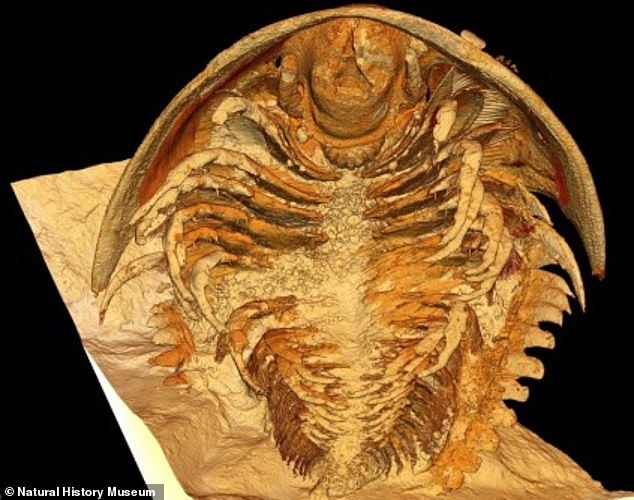
PREHISTORIC 'POMPEII' FOUND ENCASED IN ASH IS DISCOVERED
- READ MORE: New scaly creature with red eyes discovered in forest
A prehistoric creature encased in ash has been discovered - and it was given a nickname that fits its burial.
Scientists uncovered a mold from a mountain top in Morocco, finding the most pristine specimen of a trilobite they dubbed 'Pompeii.'
The creature was instantly fossilized by hot ash in sea water from a nearby volcano - similar to the fate of those in Pompeii during the Mount Vesuvius eruption in 76AD.
While more than 20,000 species of trilobite have been unearthed, scientists have only found soft tissue - but the latest discovery included everything from its digestive tract to hair-like structures that ran along the appendages.
'I've been studying trilobites for nearly 40 years, but I never felt like I was looking at live animals as much as I have with this ones,' said Dr Greg Edgecombe, a paleontologist at the Natural History Museum.
'I've seen a lot of soft anatomy of trilobites, but it's the 3D preservation here that is truly astounding,' Dr Edgecombe continued.
'An unexpected outcome of our work is discovering that volcanic ash in shallow marine settings could be a bonanza for exceptional fossil preservation.'
The ash mold was collected in the High Atlas, the highest peak of a 1,153-foot mountain range in central Morocco.
Previous work has uncovered a trove of marine fossils dating back up to 110 million years ago, which also makes the latest discovery so special.
The ash preserved the entire body of the trilobite and filled its digestive tract, allowing researchers to analyze it for the first time.
Even small 'lamp shells' attached to the trilobites' exoskeleton remained attached by fleshy stalks as they were in life.
Lead author, Prof Abderrazak El Albani, said: 'As a scientist who has worked on fossils from different ages and locations, discovering fossils in such a remarkable state of preservation within a volcanic setting was a profoundly exhilarating experience for me.
'I think pyroclastic deposits should become new targets for study, given their exceptional potential for trapping and preserving biological remains, including delicate soft tissues.
'These findings are anticipated to lead to significant discoveries about the evolution of life on our planet Earth.'
Using CT scanning and computer modelling of virtual X-ray slices, the researchers discovered that appendages found at the edge of the mouth had curved spoon-like bases but were so small they had gone undetected in less perfectly preserved fossils.
In fact, it had previously been thought that trilobites had three pairs of head appendages behind their long antennae but both Moroccan species in this study showed that there were four pairs.
A fleshy lobe covering the mouth, called a labrum, was documented for the first time in trilobites.
Co-author Harry Berks, from the University of Bristol, said: 'The results revealed in exquisite detail a clustering of specialized leg pairs around the mouth, giving us a clearer picture of how trilobites fed. The head and body appendages were found to have an inward-facing battery of dense spines, like those of today's horseshoe crabs.'
Read more 2024-06-27T18:53:45Z dg43tfdfdgfd